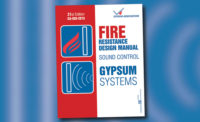A fire can catch exceedingly fast. So why would it surprise anyone that the recent rise in the use of anything that isn’t steel framing for mid-rise construction projects has been accompanied by a steadily growing catalog of fires in dozens of cities across the U.S. and Canada? Steel has an obvious advantage in that its core ingredients are fire resistant. So, that begs the question that shouldn’t more steel structures be speced and built?
According to a handbook published by the National Fire Prevention Association titled “Fundamentals of Fire Fighter Skills,” (Third Edition, by David Schottke) states: “From a firefighter’s point of view, lightweight wood-frame construction is a campfire waiting to happen. A fire in this type of construction will spread rapidly throughout the building and to adjacent exposures.” And it’s a point a view that’s echoed by fire service professionals across the country. Says Scott Marks with the International Association of Fire Fighters: “The increase in the amount of wood in the structure increases the fuel load. When you start to tally up the wood in those buildings there is an incredible amount of potential fuel load for a fire. And because of the higher combustible load, incidents go from incipient to catastrophic in very short order.”
Again, the attributes of steel framing, from its proven performance as a fire-resistant material that holds such promise to a structural powerhouse, shouldn’t be ignored. Steel doesn’t burn like wood.
Wood’s Performance
More than 10 years ago, the use of combustible wood framing was limited to buildings that were three or four stories in certain circumstances where fire suppression systems were installed. That began to change with the introduction of three very significant revisions to the 2006 model building code.
The first increased the allowable heights of wood framed buildings from 50 feet to 70 feet. Another crucial revision was to allow fire walls constructed of combustible materials (wood) to be used in Type V buildings, which prior to then had required non-combustible (steel) or fire-resistive (concrete). The justification was that once the sprinklers were installed and the fire-resistant gypsum board was applied to the framing member, it didn’t matter what was in the wall cavity. The third important change was in the evolution of the definition use of a fire wall. Starting in the 2006 codes, a fire wall was no longer considered to be just a separation of fire areas within a building, but also to allow the division of the structure into separate buildings, each subject to its own height and area limits.
Together, these revisions and others have enabled the proliferation of large multi-family and retail projects where structures up to 91 feet tall are being built with five stories of combustible wood framing installed over a one or two-story podium of noncombustible steel or concrete. Canada initially took the lead in adopting substantially relaxed code provisions, with some provinces even allowing the use of combustible wood framing up to 6 stories in height. As stated in wood industry promotions: “It (changes to the building codes) opens many new opportunities for design using wood-frame construction.”
Driven by a wood industry chasing market share, the impact of the code changes first became obvious as literally hundreds of 5- and 6-story wood framed buildings seemingly began to pop up everywhere. The SFIA tracks industry data, and in 2013 we noticed a particular surge in the specification of combustible framing for apartments, hotels, dorms, and multi-occupancy structures which for the first time in our records surpassed light steel framing at the end of that year.
Changes to Building Codes
But the changes to the building codes have had predictable results, as the chronicle of devastating fires in mid-rise wood frame buildings continues to grow. Ironically, the first building permitted under British Columbia’s new 6-story allowance burned to the ground in 2011, followed by enormous blazes in Manitoba, Quebec, Ontario and more in British Columbia. As this type of construction began to appear in the US, a similar record is being established with major fires in some of the most densely populated areas in Maryland, California, Washington, New Jersey, Wisconsin, Missouri, Texas, Pennsylvania, Arizona, North Carolina, Massachusetts, Virginia … the list continues to grow.
When one of these fuel-heavy buildings turns into an urban forest fire, it creates hazards to nearby property, as well. In Los Angeles, the DaVinci fire shut down two freeways and damaged at least four nearby buildings. The fire that burned the mid-rise wood framed apartments in Madison, Wis., in 2015 and the Royale Apartments in Kansas City earlier this year were so hot that they melted vinyl siding and ignited roof fires on nearby houses and the heat signatures for both were observed on weather radar. As more mid-rise wood framed buildings go up, firefighters increasingly are required to manage or extinguish fires that spread to adjacent buildings, a condition also experienced in the other major fires.
Insurers have long been wise to these risks. “Wood” construction has a greater likelihood to burn or be damaged by fire and will be a total loss versus a partial one. Loss history for wood construction has been poor, and carriers are very restrictive of the amount of risk they will take (known as capacity). This drives up the cost to the builder, and actually weakens the pro-wood argument that it is less expensive than other materials. Inevitably, the increase in major wood frame fires will cause major carriers to review and adjust their underwriting policies to manage the risk that this type of construction represents.
Common Sense Returns
While it may have been possible to ignore the first few fires in these mid-rise structures, the magnitude and frequency now makes it almost impossible to ignore and legislators are taking note. In New Jersey, the site of the huge blazes in Maplewood and Edgewater, at least nine separate bills have been introduced to limit the size of combustible wood framed buildings and provide additional protections for firefighters and occupants above and beyond the current relaxed provisions in the building codes. One of Atlanta’s fast-growing suburbs, Sandy Springs, passed an ordinance last year limiting wood-framed buildings to three stories in height. There already are calls for similar measures in California, Massachusetts, Florida, Georgia and the pressure for lawmakers to act grows with each and every blaze.
It’s no surprise that the wood industry and its allies have responded to this new challenge with a new set of counter-charges.
Fact: Wood construction is not the only economically viable solution.
The wood industry and their allies will claim that wood frame systems are anywhere from 22 percent to 80 percent less expensive than steel or concrete alternatives. This is intended to mislead the public and elected officials to conclude that a building that cost $10 million using combustible wood framing would cost anywhere from $12.2 to $18 million if built with concrete and steel.
In fact, the framing system of a building represents between 10 percent and 15 percent of the total cost of construction. Data provided in 2014 by developers for comparable mid-rise buildings constructed with both wood and cold formed steel found that wood framing had a first cost advantage of 3.6 percent. So, when put into true perspective, the difference between a wood frame and a steel frame system is only $288,000, without any adjustment to account for the huge increases in wood prices over the last year. But that’s not the complete story, either.
A cold formed steel system offers a builder a number of efficiencies that lower construction costs, and thus narrow the cost gap, but one of the most significant savings is for Builders Risk insurance. Because combustible framing systems represents a significantly higher risk, premiums are priced accordingly. Consequently, a builder on average will save $55,000 on insurance if that $10 million building is constructed with noncombustible cold formed steel framing. When costs associated with construction defects and installation requirements are factored in, the gap between wood and steel framing effectively evaporates.
Fact: Steel and concrete are noncombustible. Wood burns.
When a flame or heat source more than 500 degrees is applied to a wood stud it will catch on fire. If there are other wood products nearby they will, in turn, catch fire and burn. When you have very large amounts of wood in one place, like the DaVinci, one wood stud that catches fire is likely to have catastrophic results.
What happens when you apply a flame or heat source to a steel stud or concrete wall? Nothing. The studs will not ignite. They will not support the spread of the flame to another stud. Even after a seismic event, a cold formed steel building will maintain its structural integrity when exposed to a fire.
This was recently proven by the University of California, San Diego, which built a six story cold formed steel structure that was subjected to Northridge-scale seismic forces. Fire tests were then performed in eight rooms with temperatures reaching as high as 1,800 degrees. Then even larger seismic loads were applied to the structure. Although the building was badly damaged by the series of tests, the structure was still standing after all the abuse it had been subjected to. And it certainly didn’t burn.
Fact: Tougher Penalties for Arson Aren’t a Solution
More recently there’s been an attempt to lay the blame for these fires at the feet of arsonists. This is a deflection, of course. The fact is that arsonists look for things to burn. Wood burns. So, perhaps the best way to control arson is not just harsher penalties for arson but to also limit the enormous temptation posed by these new lumberyards in the sky.
A Matter of Time
One of the arguments used by proponents of pro-wood code changes is that once the sprinklers and fire-mitigation systems are in place, wood framed buildings are as safe as concrete or steel structural systems. However, what happens when the gypsum wallboard used for fire protection assemblies are subjected to the normal structural strains and the wear and tear of occupants? And what happens when part of a building’s wood structure is exposed for months during renovation or repairs, including periods of time when adjacent units are occupied?
The answer has been provided in 2015 with the inferno that destroyed the Edgewood apartment complex in New Jersey. Built in 2002, the four-story wood framed building had been constructed to code and with sprinklers for fire suppression. Twelve years after it was first occupied, maintenance who were doing a plumbing repair ignited the fire that rapidly spread inside the walls and ultimately throughout the building. The 7-alarm fire took 15 hours to contain. Fortunately, all the residents were able to escape unharmed. No one denies that combustible systems are extremely vulnerable during the construction phase but the Edgewood fire points out that the risk of wood framed systems exists through to the end of the building’s serviceable life.
I work with professional firefighters who are concerned about the use of combustible framing in these huge mid-rise buildings, and recently heard one say, “We don’t want a second round of the fire wars.” The reference is to the one million fires fought by the New York City Fire Department between 1965 and 1980, largely as a result of multi-story wood framed homes built earlier in the century and that had been allowed to deteriorate.
When I look around me and see mid-rise apartments, hotels and other similar structures, these should raise a serious question about whether today’s construction industry is using potential fire risks.
Risks are part of everyday life, but the mounting evidence calls into question whether the initial costs savings from cheaper combustible construction is worth the risk. It’s time to re-think what has happened with the building codes, even if it takes the public and community leaders to make it happen.










Report Abusive Comment